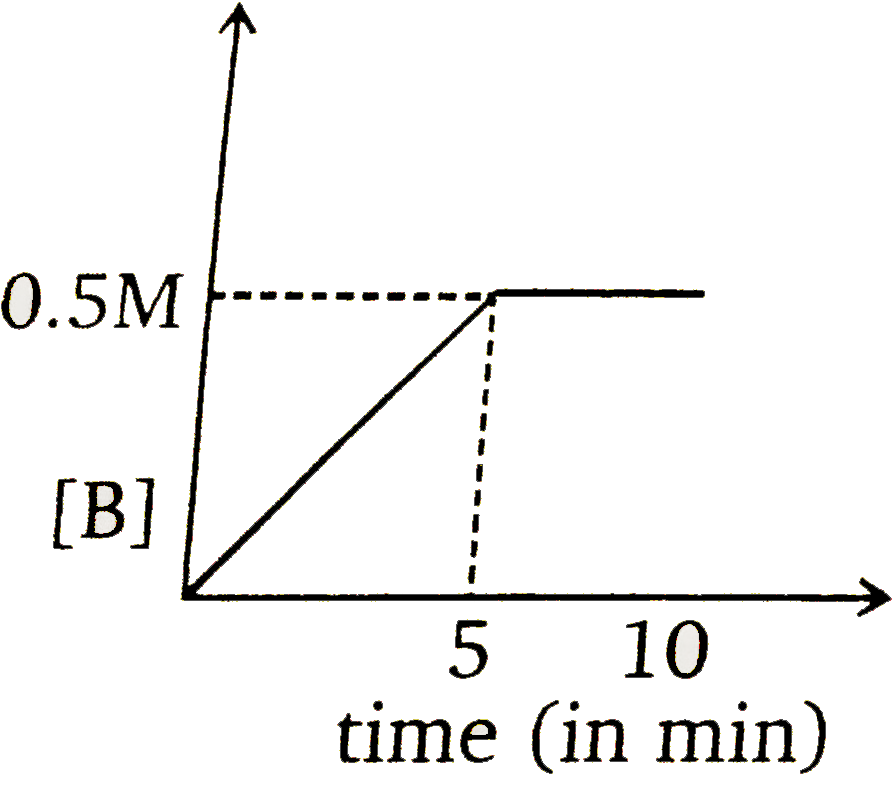For a reaction Akr=0.6M−1min−−−−−−−−→2B
starting with 1 M of 'A' only, concentration of B (in M) after 100 sec. and 200 sec. is respectively?
2 and 4
1 and 2
2 and 3
none of these
The correct Answer is:D
t100%=ak=10.6min=10.6×60sec=100sec.
Reaction will be finish in 100 sec., so concentration of Ben B will reach maximum value 2 M after 100 sec.
Topper's Solved these Questions
- CHEMICAL KINETICS BOOK - DISHA PUBLICATIONCHAPTER - CHEMICAL KINETICS EXERCISE - EXERCISE 1 : CONCEPT BUILDER (TOPICWISE)(TOPIC 3 : Theories of Rate of Reaction)
17 Videos
- CHEMICAL BONDING AND MOLECULAR STRUCTURE BOOK - DISHA PUBLICATIONCHAPTER - CHEMICAL BONDING AND MOLECULAR STRUCTURE EXERCISE - EXERCISE-2: CONCEPT APPLICATOR
30 Videos
- CHEMISTRY IN EVERDAY LIFE BOOK - DISHA PUBLICATIONCHAPTER - CHEMISTRY IN EVERDAY LIFE EXERCISE - Exercise
88 Videos
Similar Questions
For a reaction : A(g)→nB(g) the rate constat is 6.93×10−4sec−1. the reaction is performed at constant pressure and tomperature of 24.63 atm and 300K starting with 1 mole of pure A.
If concentration of B after 2000 sec is 33.25M then calculate the value of n
View Solution
Let the initial concentration of P is 1 M, the concentration of P after 33.33 sec is equal to?
View Solution
Knowledge Check
For a reaction Akr=0.6M−1min−−−−−−−−→2B
starting with 1 M of 'A' only, concentration of B (in M) after 100 sec. and 200 sec. is respectively?A2 and 4B1 and 2C2 and 3Dnone of theseConsider a reaction A(g)k=0.1M−1min−−−−−−−→2B(g). If initial concentration of A is 0.5 M then select correct graph.
A B
B C
C D
D
The reaction A(g)→B(g)+2C(g) is a first order reaction with rate constant 3465×10–6s–1. Starting with 0.1 mole of A in 2 litre vessel, find the concentration of A after 200 sec., when the reaction is allowed to take place at constant pressure and temperature.
A0.05MB0.025MC0.0125MDNone of these
aX→bY. The initial concentration of X is 0.6 M. After 10 min interval of time the concentration of X and Y are found to be 0.3 M and 0.2 M, respectively. Calculate the stoichiometric coefficients and rate of reaction with respect to X and Y.
View SolutionIn the reaction A→B+C, rate constant is 0.001Ms−1. If we start with 1 M of A then conc. Of A and B after 10 minutes are respectively :
View SolutionThe rate law expresses the relationship of the rate of a reaction to the rate constant and the concentration of the reactants raised to some powers for the general reaction.
aA+bB→cC+dD
Rate law takes the form
r=k[A]x[B]y
where x and y are number that must be determined experimentely k is the rate constant and [A] and [B] are concentration of A & B respectively.
The initial rate of zero order reaction of the gaseous equation A(g)→2B(g) is 10−2M−1min If the initial concentration of A is 0.1 M what would be concentration of B after 60 seconds ?
View SolutionFor a reaction ,
A⇔B,d[A]dt=5×10−4[B]−4×10−3[A]Mmin−1 Starting with only A at 0.1 M concentration calculate concentration of B after time t=9200sec.
[Given:In 2=0.69]
View SolutionFor the reaction,
A+B⇔2C
KC=1. If the initial concentration of A,B and C are 1m, 1m and 2m respectively then, at equilibrium.
View Solution
